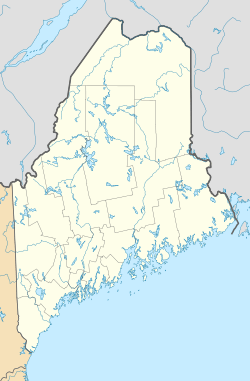Waterford Historic District (Waterford, Maine) facts for kids
|
Waterford Historic District
|
|

Waterford's First Congregational Church
|
|
| Location | ME 35 and ME 37, Waterford, Maine |
|---|---|
| Area | 35 acres (14 ha) |
| Architect | Multiple |
| Architectural style | Greek Revival, Federal, Colonial Revival |
| NRHP reference No. | 80000247 (original) 11000583 (increase) |
Quick facts for kids Significant dates |
|
| Added to NRHP | April 24, 1980 |
| Boundary increase | August 23, 2011 |
The Waterford Historic District is a special area in the small town of Waterford, Maine. It's also called Waterford Flat. This district protects many old buildings that show how the town grew. People first settled here in 1775. The town grew near where Kedar Brook flows into Keoka Lake. The oldest building still standing is the Lake House, built in 1797. Most houses in the district were built before 1850. Important public buildings here were designed by a famous architect named John Calvin Stevens. These include the Knight Library, Wilkins Community Hall, and First Congregational Church. The district was added to the National Register of Historic Places in 1980. This means it's a very important historical place!
Contents
Exploring Waterford's History
The town of Waterford was first explored and settled in 1775. In 1793, a person named Eli Longley built a log cabin. It was near the mouth of Kedar Brook, close to Keoka Lake. Four years later, in 1797, he built a larger building. This building is now known as the Lake House. It was a tavern, a place where travelers could stop and rest.
How the Town Center Grew
The town center of Waterford grew on Eli Longley's land. He helped plan how the town would be laid out. The historic district follows along two main roads: Maine State Route 35 and Maine State Route 37. It stretches from the town green, going south. It also goes north past Kedar Brook to where Rice and Waterford Streets meet. Some parts of Plummer Hill Road and Valley Road are also included.
There are 27 important historical buildings in this district. Most of them are homes built before 1850.
Famous Homes and Buildings
One interesting house is the Levi Browne House, built in 1805. This was the birthplace of a funny writer named Charles Farrar Browne. He was born in 1834 and died in 1867. He wrote under the pen name Artemus Ward.
Another beautiful old house is the Ambrose Knight house. It's a great example of the Federal style of architecture. Ambrose Knight owned a shop in the town. The oldest government building in the village is the town house. It was built in 1843 and shows the Greek Revival style.
Buildings from Later Years
Between 1850 and 1900, a few more buildings were added to the district. These buildings show different styles. Some are Italianate, which means they have features like low-pitched roofs and wide eaves. Others mix Greek Revival and Italianate styles.
The Leander Stone House is a good example. It was built around 1870 by a local builder for his family. The Masonic Hall was also built by Stone in 1879. Most of the public buildings in the district were built before 1930. They are in the Colonial Revival style.
Buildings by a Famous Architect
Three of these important buildings were designed by John Calvin Stevens. He was a well-known architect from Portland. He designed the First Congregational Church and the Wilkins Community Hall next to it. Both were built in 1928. The Knight Library was first built in 1911-1912. Sadly, it was destroyed by fire. It was rebuilt in 1938, following a plan by Stevens.



